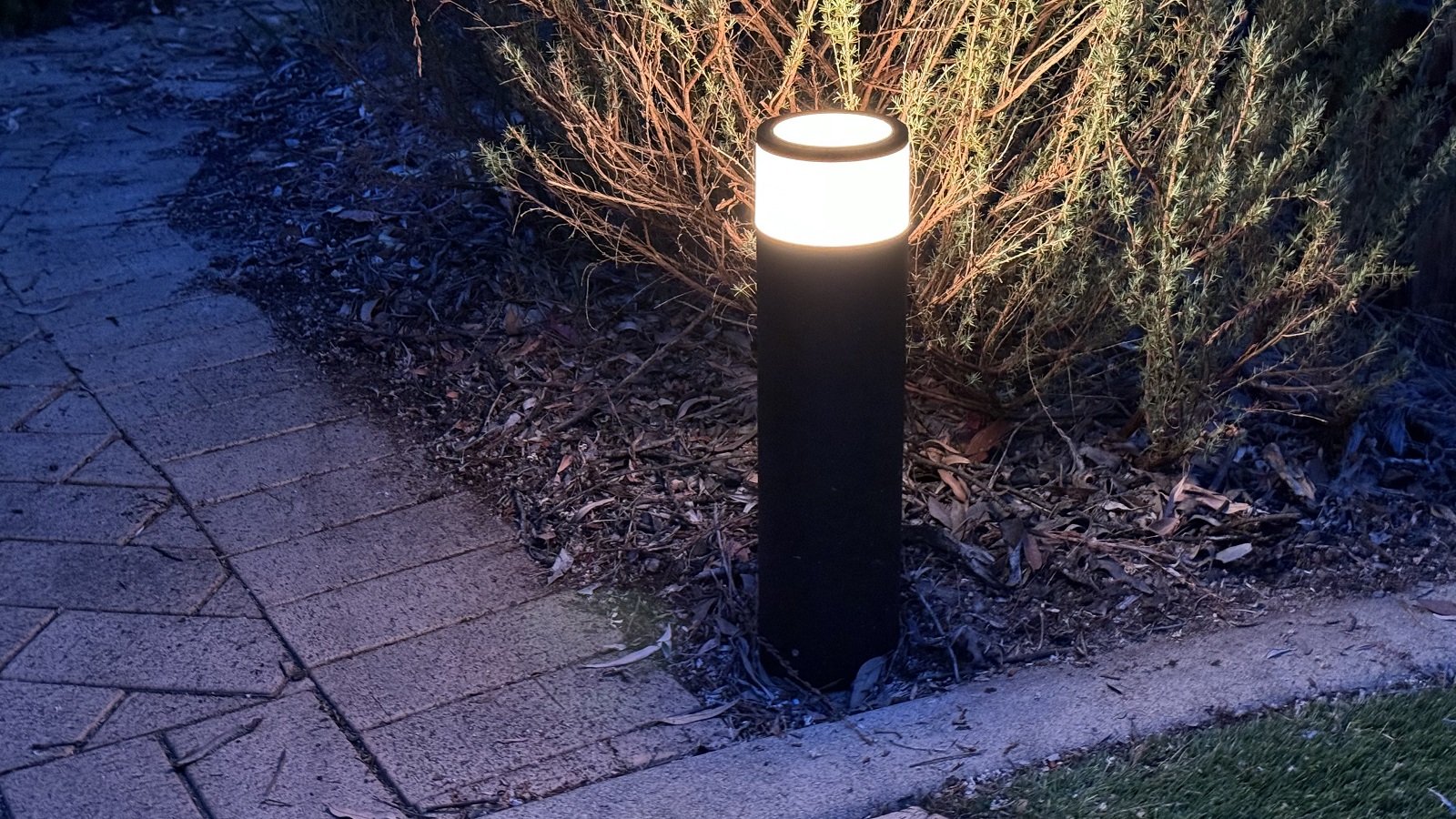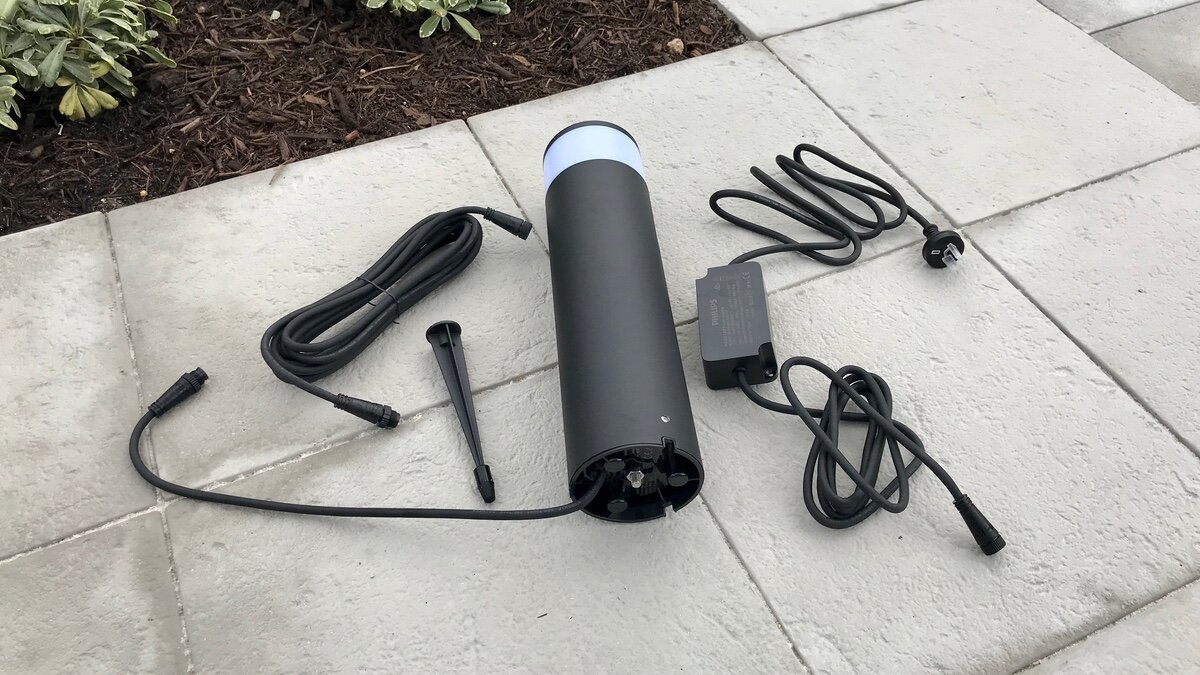Philips Hue Calla Pedestal Review: Still Reliable 3 Years In
When you buy through links in this article, I may earn an affiliate commission. Learn More.
I’d been looking for an excuse to review the Philips Hue Calla outdoor lights for a while, so when we finally put in a pool it presented the perfect opportunity to give them a solid workout.
Having run a Hue lighting setup for some years now, I expected these would be a good option for outdoors thanks to the mesh networking capability of the Hue system. I also wanted to be able to integrate them into my smart home for automation opportunities, which Hue also excels at.
I’ve been really happy with the ease of installation, and flexibility afforded by the extendable cabling system. I’ve been able to combine these with the Lily garden spots without having to have excessive power packs or duplicate cable runs, and the design is smart and effective.
There are, of course, caveats and some things that could do with improvement, so we’ll look dig into those as well as the performance and usage of the Calla lights.
Pros
✔ Flexible installation options✔ Responsive full color lighting
✔ Excellent smart home support
Cons
✔ Needs a ZigBee hub✔ Limited to 600 lumens
✔ Plastic diffuser can discolor over time
The Calla is a weatherproof outdoor light that falls into the category of ‘path light’, ‘bollard light’, or ‘pedestal light’, depending on where you’re from. Whichever you choose to call it, it the kind of light that comprises a short post with the light built into the top portion. There are many designs of these, but the Calla has gone with a modern, minimalist look which makes it easy to fit into any landscape design.
The Calla comes in two packaged versions, the base version and the extension. You need to start with a base package as it contains the low voltage (24V) power pack. Extensions can be added on, and each comes with a T-connector so you can tap them off the single cable run. Additional extension cables can also be purchased separately for those longer runs.
The light is constructed of powder coated aluminium and has a good heft to it. A short built-in cable (600cm/2 feet) connects to the power supply, but it also comes with a 5m/15ft extension which gives a lot more placement flexibility. The cables are well insulated and durable, with screw-in water resistant connectors used throughout. There is also a sturdy cast aluminium ground spike which can optionally be attached to the base of the unit via a stainless-steel screw fitting.
The pedestal light itself is fully outdoor rated with a rating of IP65, so it can take a blast from the hose or heavy rain without issue. The power supply is rated at the much higher IP68, which is the same immersion rating as modern smart phones. While it can be temporarily immersed, Philips recommends mounting it above ground level using the provided screw holes in opposite corners to protect it from prolonged exposure (sitting in puddles for example).
Hue Calla Box Contents
At 25cm/1 foot in height, the Calla presents quite a solid appearance without being too intrusive. The height is enough to provide good light throw above smaller plants and variations in ground height. Notably, in addition to the wrap around diffuser that throws light horizontally, the top also has a diffuser allowing some upwards light to provide a nice ambient glow on any nearby walls or plants.
The durable cable can be run above ground, or buried without issue, and feeds into the base of the unit through one of three notches around the bottom edge. Due to the metal casing, the internal Zigbee radio antenna is positioned behind a small black plastic panel on one side to allow the radio signal to get through. Ideally you would point that side towards the house, or other Hue lights to allow good signal. The three notches are provided to allow that to happen without constricting your cable placement.
Like other Hue lights, the Calla uses that Zigbee signal to provide highly responsive control and built in mesh networking. This means they only work with a Hue Bridge, but it also makes them particularly useful for outdoor situations which could easily be a stretch for your Wi-Fi signal. Running a string of Calla lights allows them to run away from the house and bounce the signal between each other to keep in contact.
Installation and Setup
That string can be up to five lights long off of a single power supply, and with the provided extensions, can run up to 35m/100ft. Hue now has an optional 100W power supply that run double your number of lights off a single socket. As each attached light is independent of the others, you can mix and match compatible Hue outdoor lights on the same power supply, such as the Lily spotlight. Each light handles its own communications and can be controlled separately through the app or your smart home platform.
Installation can be both in-ground or fixed to a hard surface. The bottom of the unit is a thick plastic which is screwed into place. By removing this you can screw through the provided indents to mount it firmly onto a deck, path, or retaining wall and then reattach it to the casing. These indents are about a finger width lower that the base itself which helps to prevent any leakage from affecting the unit.
Installation using the ground stake was super simple for me, but you want to be careful if your ground is hard clay or particularly rocky. As the screw mount is attached to the plastic base a small number of people have reported snapping it off, although that may be case of heavy handedness.
With freshly landscaped gardens I certainly had no concerns pushing it in. If you are concerned, you can push in the stake first to create the hole, then attach it to the light to avoid any excessive force.
If you run a Hue system already, getting them set up in the Hue app is as simple as any other Hue light. Power them up, open the Hue app, Go into Settings > Lights and add a new light.
The Calla should appear automatically so long as it’s in range of your other Hue lights or the bridge directly. Tap it to pair to your network. Once it’s paired, you can name it and assign it to a room, and you’re good to go.
Running the Calla cables
Lighting up the back path
Poolside Callas at night
Real World Usage
Light Output
In terms of light output, the Calla is a full color gamut luminary which puts out a maximum of 600 lumens. That’s enough to provide good mood lighting for entertaining areas, and certainly enough for path and garden illumination. The fact it throws light upwards through the top helps to better illuminate the general area over just casting it horizontally. This means it can double as a feature light as it will nicely light up a wall, post, or plant that is next to it as well.
With three of these placed around the pool patio, and three on the opposite side of the pool I’ve found it very pleasant for sitting outside with guests, using the pool on a summer evening, and having a few drinks. You may want a bit more light for a sit-down meal but this is more due to the low position of the lighting rather than the output. I find it quite adequate, buy obviously preferences will vary on this point.
I’ve paired these with a Hue Outdoor Motion Sensor to fully automate the lighting. With this place on a patio post facing the pool it easily detects any motion in the area and keeps the lights on and makes sure they go off when we leave. But I can also use other automation rules or voice commands thanks to integration with my smart home.
Smart Home Integration
Philips has always had excellent smart platform integration, and any of their lights that connect via the bridge inherit this automatically. This covers all three major voice assistants, Alexa, Google Assistant and Siri, with full integration with Apple’s HomeKit, as well as linking with Wink, SmartThings, Logitech’s Harmony, and a variety of other proprietary controllers. Even without these, Hue’s own platform provides for automation functions like location-based triggers, so your path lights can turn on when you arrive home for example, and scheduled timers with various fading and color effects.
Durability
I’ve had these installed for 3 summers now, and so far, they haven’t skipped a beat. They get splashed with pool water and exposed to full sun and rain, and still look mostly fine. I say mostly because the powder coat has begun to fade depending on the amount of UV they individually get. You can see how they’ve held up in the photos above. My other concern is the white diffuser parts. The light comes through translucent plastic, not glass. That’s a shame as it’s the only part that doesn’t feel up to the price tag.
After several full summers of intense sun there has been some yellowing on those that get a lot of sun (many are in shade much of the time thanks to the plants), but not enough to cause a significant change in the color output. The bigger concern is whether this will cause the plastic to become brittle over the longer term. The Calla has a 2-year warranty, but any adverse effects are likely to occur beyond that, although I have yet to see anything.
As for them actually working as intended, though, I have had absolutely no issues with the lights themselves. Despite being subjected to pretty brutal summers and daily use they just keep on trucking. The only reliability issue I’ve encountered was one of the T-connectors became a little temperamental and was giving intermittent power to one of the Calla units. A firm re-insertion has resolved that, so it may have not been connected quite right from the beginning. There connectors can be easily swapped out, though, so if it causes any more issues, I can just replace it without impacting the lights themselves.
The Verdict
When it comes to outdoor smart lighting, options are still pretty limited, but improving. For path and bollard lighting options in particular, there really isn’t much choice on offer with smart home connectivity. The Philips Hue Calla is a high-quality product, with great smart integrations, a stylish unobtrusive design, and good brightness and color for those outdoor parties and poolside drinks.
While it does require a Zigbee bridge to use, if you’re a current Hue user the Calla is a perfect fit. If not, you can also get by with third party bridges from Wink, SmartThings and even Amazon’s latest Echo Plus which has a built in ZigBee hub.
I’m certainly loving the ambience and automated control around our outdoor entertaining area with these installed. In fact, we loved the first few so much, we extended the set all the way around. It’s a pricey option, for sure, but there really is no competition in its class right now.









